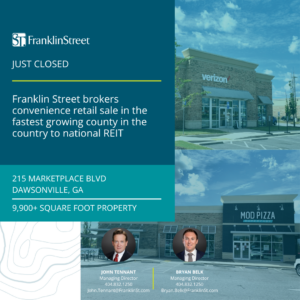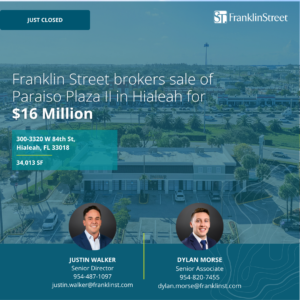The national trend of people moving into the urban core has hit downtown Fort Lauderdale in a big way and is transforming the central business district by putting more people on the streets at all hours.
The downtown area has over 12,000 residents and should exceed 15,000 in the next two or three years, given all the residential projects in the works, said Chris Wren, executive director of the Fort Lauderdale Downtown Development Authority. City planning documents show the capacity for more than 25,000 residents, he added.
More than $1 billion has been invested in projects in the CBD in the last year and a half, Wren said. Much of that has been for apartments. There are 3,000 new, under construction or approved for development and funded, said Robert Given, vice chairman of the institutional group at CBRE and a downtown resident. An additional 1,500 apartments are in the pipeline, seeking approval.
Given compares downtown Fort Lauderdale to Miami’s Mary Brickell Village 10 years ago.
“It’s a macro movement across the country to want to be in more urban centers – millennials moving into areas with a high degree of walkability and entertainment,” he said. “It’s a very attractive place to work, the retail amenities are starting to come, and a critical mass of residents is being created.”
Given said large investors are taking notice of a prime property he’s marketing downtown: the 3.7-acre Las Olas Riverfront.
Merrimac Ventures President Dev Motwani, who bought the property after it was nearly emptied of tenants during the recession, said he’s looking for a joint-venture partner to develop it as a large-scale project.
While there’s little office development in South Florida now, it should be no surprise that’s under consideration here. Office rents on Las Olas Boulevard are comparable to Brickell Avenue, and the vacancy rates are low, Given said. Several groups are looking to build office towers on Las Olas, Given said.
The strong office market attracts wealthy workers to live nearby, as reflected in the $101,000 average household income in the 33301 ZIP code. Given said the household income of the new occupants of downtown Fort Lauderdale apartments is more like $120,000. These projects are attracting wealthy renters with high-end appliances, fixtures and amenities, he said.
The new downtown residents are a mix of young professionals, retirees and empty nesters from the suburbs looking to downsize – and they prefer an urban lifestyle, Stiles Corp. President Douglas Eagon said. The Fort Lauderdale-based company has developed more than 3 million square feet dowtwon. Its latest project, in partnership with Rockefeller Group, is a 254-unit apartment tower along LAs Olas Boulevard.
Eagon said the new apartments, downtown and extending north into Flager Village, have changed the are area from a 9-to-5 business district to a vibrant, 24-hour city.
As opposed to the Miami high-rise market that’s primarily driven by condos for foreign investors, Fort Lauderdale has mostly new apartment towers, and the renters are primarily people who live and work in the area – although there are some part-time residents, Eagon said.
“The baby boomers have sold their homes, but aren’t sure what they want to do next,” he said. “You have people who are pure renters by choice. There are some people who aren’t in the position to purchase a home because of past credit history of losing a home or their inability to make a down payment.”
Miami-based the Related Group has bought into the downtown Fort Lauderdale market with four rental projects. The Manor at Flagler Village and New River Yacht Club I are completed, Incon Las Olas is under construction and New River II is set to break ground soon.
Carlos Rosso, president of Related’s condominium division, said it’s building apartments there because the rental market is strong and it doesn’t want to compete with the condos at its Fort Lauderdale beach projects such as Auberge Beach Residences. However, he expects to eventually convert Icon Las Olas into condos.
The city hasn’t attracted the same kind of international attention that Miami has, Rosso said.
“Fort Lauderdale isn’t known as being a fashion place, and they are losing to Miami Beach in that respect,” he said. “They could market themselves and try to upgrade the image as a place people to to celebrate and sell cheap T-shirts to a place that is high end.”
As for the existing downtown Fort Lauderdale condo market, there’s very little inventory available and prices are increasing, said Athena Rossano, director of market research at Related ISG Realty. The entire Fort Lauderdale market, including the beach, absorbs about 470 units annually and has 711 units under construction, with 32 percent of them sold, she added.
The influx of residents has boosted the restaurant and retail market near downtown, especially along Federal Highway (U.S. 1) just north of the city, said Gregory Matus, regional managing partner for commercial brokerage Franklin Street in Fort Lauderdale. Retail rents are approaching $60 a square foot along that corridor, and the vacancy rate is low, he said.
“People are already going downtown for the quality of the restaurants and nightlife, so the next logical step is for hospitality and shopping,” Matus said. “It’s a great alternative for retailers because rents are lower than the [Miami] Design District or Brickell. For Lauderdale is benefiting from the growth in Miami because businesses are moving up in our direction.”
Eagon said the downtown population density isn’t large enough to support a mall yet, but there’s strong demand for ground-floor retail space in office and residential buildings, especially on Las Olas Boulevard. Given said conditions are good for a high-end grocer to open.
For Lauderdale is counting on transportation projects to boost mobility for city residents and visitors, and energize properties along transit routes. The $143 million Wave Streetcar is expected to begin operations in late 2017 along a 2.7-mile track between Southeast 17th Street and Sistrunk Boulevard. The city projects it would carry over 3,200 riders daily. Wren said the DDA is in the midst of installing dozens of interactive maps to show visitors where the attractions, events and transit connections are.
“People now, especially millennials, want to live in urban environments where they don’t have to buy cars,” he said. “The stations will be like little town squares.”
A station for All Aboard Florida, a passenger rail connecting Fort Lauderdale to Miami, West Palm Beach and Orlando, is also slated to open in 2017. Given said it would be a major advantage for both residential and office in downtown Fort Lauderdale because people will have easy access to Miami’s large job market and populations center.
“That will draw businesses back from the suburbs,” Given said. “There’s no doubt that, when those stations open and when that streetcar opens, it will spur a whole new wave of development in downtown Fort Lauderdale.”



